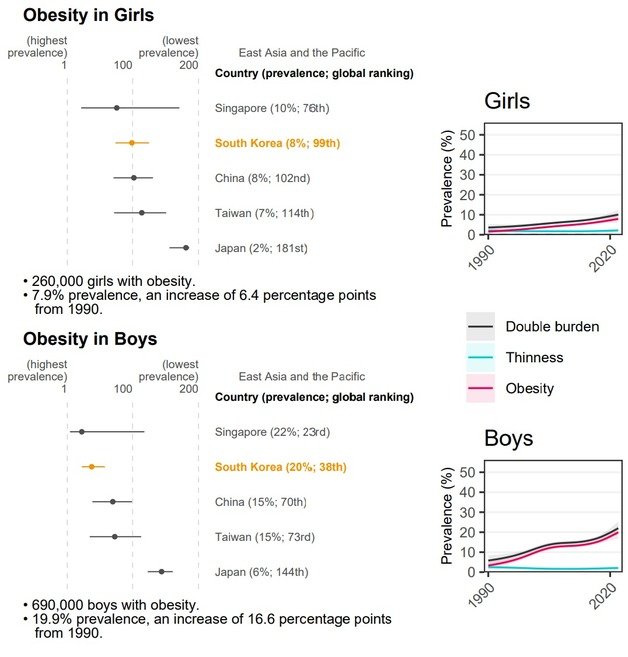As a result of compiling obesity rate data from around the world, Korea’s obesity rate among male minors (ages 5 to 19) was 19.9%, ranking 38th out of 200 countries.
According to the scientific community on the 4th, the Network of World Health Scientists (NCD-RisC), jointly researched with the World Health Organization (WHO), published a study on underweight and obesity population data from 1990 to 2022 in the international academic journal Lancet.
This study found that Korean adult women increased from 2.2% in 1990 to 5.7% in 2022, and Korean adult men increased from 0.9% to 8.8%.
The obesity rate ranking by country in the world in 2022 is 194th for adult women and 150th for adult men.
Korean underage women ranked 99th, increasing from 1.5% to 7.9% over the same period. In the case of Korean underage males, the number increased from 3.3% to 19.9%, ranking 38th in the world.
 Chart of female (above) and male obesity rates among Korean minors (ages 5-19) in 2022. The proportion of underage women was 7.9% (6.4 points higher than in 1990), ranking 99th in the world. Korea’s underage male population is 19.9% (16.6 points higher than 1990), ranking 38th in the world. (Captured by the World Health Organization and the World Network of Health Scientists (NCD-RisC)) 2024.03.03 / News 1
Chart of female (above) and male obesity rates among Korean minors (ages 5-19) in 2022. The proportion of underage women was 7.9% (6.4 points higher than in 1990), ranking 99th in the world. Korea’s underage male population is 19.9% (16.6 points higher than 1990), ranking 38th in the world. (Captured by the World Health Organization and the World Network of Health Scientists (NCD-RisC)) 2024.03.03 / News 1From 1990 to 2022, the global obesity rate increased from 4.8% to 14% for adult men and from 8.8% to 18.5% for women.
During the same period, the obesity rate among male minors increased from 2.1% to 9.3%, and among female minors it changed from 1.7% to 6.7%.
“Being overweight during childhood and adolescence has implications for the immediate health of children and adolescents and is associated with the early onset of type 2 diabetes and cardiovascular disease,” WHO said. “It can also lead to negative psychological and social outcomes,” he explained.
As of 2022, the number of obese people around the world is expected to exceed 1 billion. From 1990 to 2022, the adult obesity rate more than doubled, and the obesity rate among minors, including children and adolescents, quadrupled. On the other hand, the rate of underweight decreased.
In terms of population size, 879 million adults and 159 million minors were found to be obese.
In this study, obesity was divided based on body mass index (BMI). Adults were classified as obese if their BMI was 30 or higher, and obesity criteria using standardized BMI were applied to minors whose weight and height fluctuated rapidly.
BMI has limitations in that it does not reflect the amount of muscle and fat and body fat distribution, but it is widely used in obesity trend research because of its simplicity in measuring only height and weight.
WHO Director-General Tedros Adhanom Ghebreyesus said, “This study highlights the importance of preventing and managing obesity from infancy to adulthood through diet, physical activity, and appropriate management as needed. “For the world to achieve obesity control, efforts from WHO, governments, and local communities are needed.” He also urged cooperation in the private sector to take responsibility for the health effects of various products.
Source: Donga
Mark Jones is a world traveler and journalist for News Rebeat. With a curious mind and a love of adventure, Mark brings a unique perspective to the latest global events and provides in-depth and thought-provoking coverage of the world at large.